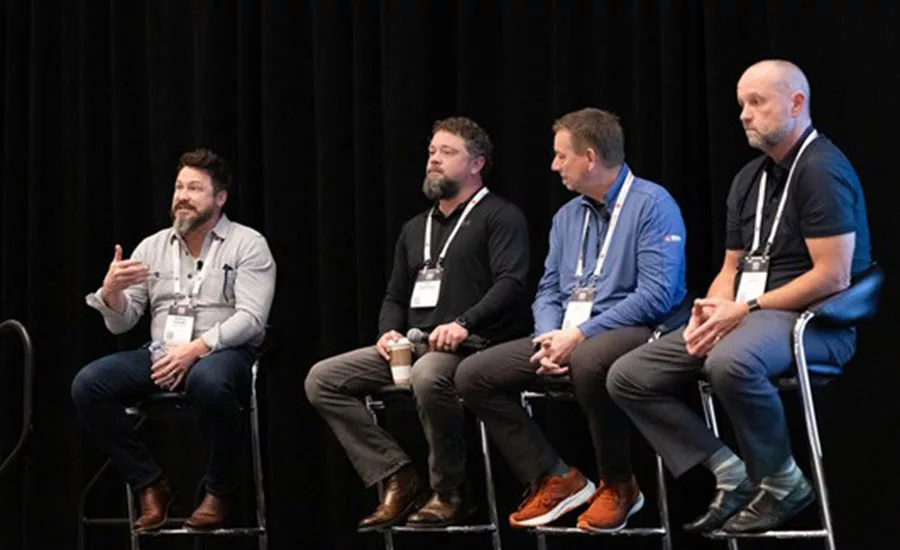Radiant Barriers
There are limitations. The emerging markets are currently for residential buildings in the Sunbelt, but commercial markets are being identified. And the question of which contractor is best qualified to install is unanswered in many states. Still, RBs have the potential to become a standard consideration for roofing systems.
Radiant barriers have been around since soon after the availability of cheap aluminum and have been used most effectively to repel afternoon heat in factories and other uninsulated buildings in the Sunbelt. Because aluminum reflects thermal radiation (up to 97 percent), but emits very little heat, it is very effective at keeping the heat coming from a roof out of the building. Radiant barriers are most efficient at reducing peak loads, and research is underway that may usher in a new way of thinking about lowering your payments to energy traders.
Heats Up
The physical properties of aluminum have been known for a long time and are used in many roofing applications, from accessories to fire-rated systems. If RBs haven’t shown up on the roofing radar, it is because they have been traditionally employed under the decking. In order for the aluminum to reflect solar radiation — that’s most of the heat coming through the roof — there must be a barrier of at least 3/4-inch of air space. That “short circuits” the conduction of solar radiation, most of which is reflected back up into the system and the outer environment.Cost savings range wildly as does the installation price (10 cents to $1 per square foot). According to one study by the Florida Solar Energy Center, attic temperatures in Florida homes were lowered by an average of 8 degrees, which was a noticeable improvement to the occupants. In California, energy conservation is a powerful culture and RBs can directly address one of the most critical energy needs there: conservation during peak loads.
John Ziegenhorn has been involved in roofing since 1987, but for the past year and a half, he’s been promoting RBs through his company, Ultimate Barrier in Lake Elsinore, Calif. As homeowners replace their roofs, Ziegenhorn has been working with
Bienek Roofing in Lake Forest to install Ultimate Barrier’s product. The two layers of aluminum sandwiched around 100-pound craft paper are attached on the bottom side of the joists. The perforated rolls won’t build up condensation and each one covers 1,000 square feet. With conventional insulation above the ceiling, Ultimate Barrier has been performing as expected.
“I very seldom run my air. I don’t need it,” says Ziegenhorn. “I’ve cut my
(electric) bill by 50 percent.”
He’s got testimonials from homeowners and has been receiving local media coverage. But measuring energy savings can be a tricky matter and there is limited research on the effects of radiant barriers — none of it is based in colder climates. Test results from FSEC plus houses in Knoxville, showed that homeowners in the southeastern United States can reduce annual cooling costs by 8 to 10 percent, more if air conditioning ducts are in the attic above insulation.
Other estimates range from a 2- to 10-percent reduction of the year-round energy bill. That may not make the phone ring, but consider a lifetime of maintenance-free energy savings. People would flock to the bank to save 2 percent on their mortgage.
Oak Ridge National Laboratories conducted tests of radiant barriers and found that radiant barriers in homes with R-19 insulation in attics can reduce their cooling bill by 10 to 25 percent. Depending on usage during the hot, Florida summers — not to mention the value of reducing peak demand — radiant barriers can reduce a typical homeowner’s electric bill by up to 17 percent during the dog days. However, an ORNL test of 19 houses in Tulsa couldn’t prove that radiant barriers or even attic insulation reduced cooling costs of window units.
So far the market has been modest. Bienek has done about 60 installations.
Ziegenhorn first came across RBs in 1986, but only recently became an evangelist. With afternoon highs over 100 degrees F and a lingering power crisis in the West, a lot of people are energized.
“Their electric bills were rising rapidly,” he says. “The homeowners want this. I enjoy helping them because they’re is nothing worse than having them call and say, “Why didn’t you tell me about this?’”
Elusive Emissivity
The building trades have employed “low E” windows that have low emissivity and transfer less of the heat that it absorbs from the sun. That foil-faced insulation board used in roofing has the same fundamentals, but it is generally not there as a radiant barrier. Unless sufficient air space over the foil is engineered into the project (fishmouths don’t count), the heat from the roof transfers directly to the foil which then transfers the heat to the insulation which only then begins to block the heat.Roof insulation manufacturers stay with R-values and few if any promote the reflective properties of foil facers. At least one company — Celotex — got FM approval to have the aluminum sheet on its batten insulation face downward, but the reason was for aesthetics rather than energy.
However, wall insulation is another story. The foil-faced insulation can be engineered to reflect the radiant heat back into an air cavity. Reflective insulation uses thin sheets of aluminum (occasionally in conjunction with sheets of thin plastic or paper) to form multiple layers. The “trapped” air space acts as the board insulation, which itself traps gases in plastic cells.
One strong candidate for RBs is the tremendous amount of metal roofing in the country. Since steel is an excellent conductor of heat, RBs can reduce those loads significantly. The temperature difference between the roof and interior is even greater for buildings with no insulation.
“I think warehouses and shops ... are a pretty good market for this product,” says David Yarbrough, a technical consultant for the Reflective Insulation Manufacturers Association. “What the radiant barrier does is reduce significantly the amount of heat that’s coming down from the roof.”
RIMA, which is celebrating its 20th anniversary, is promoting reflective insulation, radiant barriers and radiant control coatings. While reflective insulation carries an R-value, the latter two must quantify their properties by other methods. Programs like EPA’s Energy Star promote the energy efficiency of products, but nailing down the reflective properties of coatings to a specific number like R-19 is elusive.
The State of California Energy Commission reviews standards every year, but this year’s review is getting special attention. For years, builders have had to obtain energy compliance permits that certify that their new designs — from walls to appliances to roofs —are energy efficient.
Len Zola, a radiant barrier consultant, has spent the last seven years promoting reflective and radiant technology. Because building practices are so code-driven, Zola is trying to make changes at that level so that Californians can conserve energy, save money and make their homes more comfortable.
“We’re presenting new reasons why radiant barriers should be given increased credit in the California Energy Code,” says Zola, who spent 20 years promoting traditional insulation before his new mission. “It’s very frustrating right now.”
It seems that every company has California in the cross hairs and government officials are inundated with magic bullets that will solve the state’s energy woes. Zola hopes to make his mark with new data from an accredited lab that opens a new front in the energy conservation war. According to him, some traditional insulation experiences a temporary degradation in R-value when it is bombarded by infrared heat. If the claims hold up, then RBs become even more valuable because they not only repeal heat themselves, but they would also make existing insulation perform better during peak loads.
“R-values are not the totality of what’s going on, especially in summer conditions,” says Zola, who expects an uphill battle against powerful forces. “It’s going to be somewhat controversial.”
Like wind chill and heat index, there may be a new way to measure the weather, this time inside the building. Vapor retarders and building wraps are now commonplace. Radiant barriers don’t have hurdles like exotic materials, patents, a new trade, elaborate installations or engineering. It’s a new way of thinking for a country that’s more serious about conserving energy. The alchemy of timing, exposure, codes and performance may combine to make RBs a standard for any roofing system.
For More Information
DOE Radiant Barrier Tests, Oak Ridge National Laboratories: www.ornl.gov/roofs+walls/radiantReflective Insulation Manufacturers Association: www.rima.net
Florida Solar Energy Center: www.fsec.ucf.edu
Looking for a reprint of this article?
From high-res PDFs to custom plaques, order your copy today!



